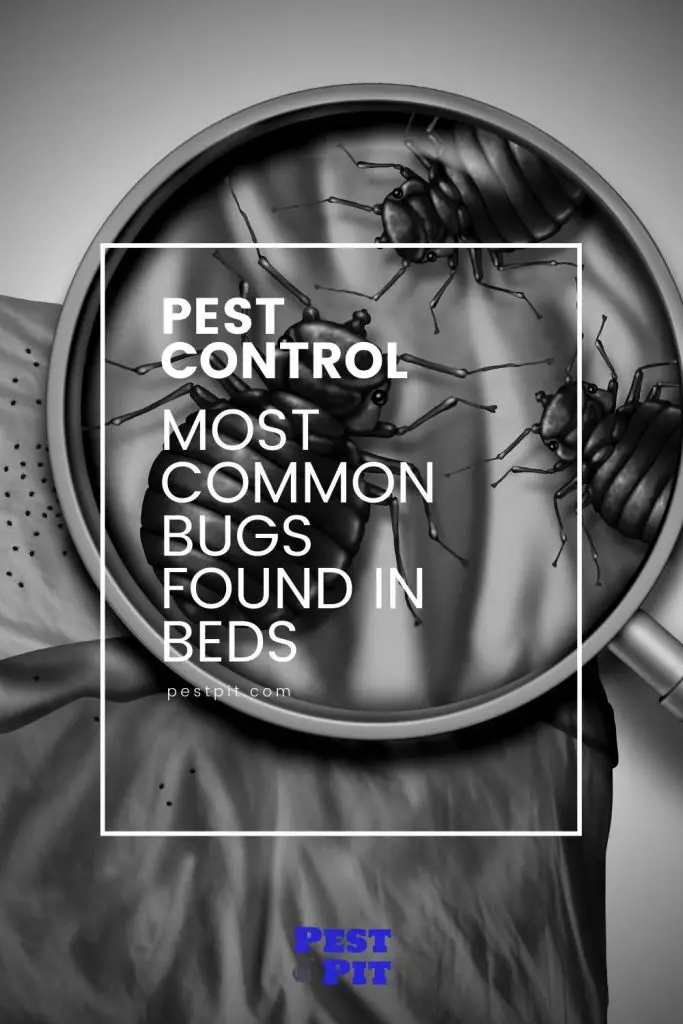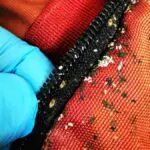Your bedroom is supposed to be a place of rest and comfort.
But, when you discover it’s been invaded, you likely won’t rest until you’ve found and eliminated the culprits responsible.
Identification is the first and arguably most important step towards getting the bugs out of your bed – Once you know what you’re dealing with, you can implement effective countermeasures.
What are the other bugs most commonly found in a bed?
9 Of the Most Common Bugs Found in Beds

Let’s Begin With The Obvious – Bed Bugs
Bed bugs are the most common bedroom invaders. They are small oval-shaped insects that feed off the blood of human beings and other warm-blooded animals.
Although the name suggests they live only in beds, bed bugs can live anywhere in your home and will hide in cracks in furniture or any textile, including upholstery. That said, infestations are most common in beds, so you will likely find them in your bed frames, mattress, and box springs.
Bed bugs do not have wings, but they can quickly scamper over walls, floors, and ceilings. Female bed bugs can produce hundreds of offspring over a lifetime. Under ideal conditions, the insects can mature in as little as a month and produce three or more generations each year.
Bed bugs may get into your home unnoticed through clothing, luggage, used furniture, and other items. Since their bodies are narrow and flat, it’s easy for them to fit into tiny spaces. They do not make nests like wasps or ants, but bed bugs usually congregate in idling places.
These parasites feed exclusively on blood, so having them in your home does not mean you are dirty. You’re just as likely to find them in a clean hotel as a dirty one.
Bed bug bites rarely hurt, but they can develop into itchy welts. Unlike fleas that prefer to bite around the ankles, bed bugs will bite any exposed skin they can find
If you wake up with itches you didn’t have when you went to bed, you may have a bed bug problem on your hands. Other signs may include
- Bloodstains on your pillowcases or bedsheets, rusty, dark spots of bedbug excrement on mattress and sheets, walls, and bedclothes.
- Fecal spots, eggshells, or shed skins in the places where bed bugs like to hide.
- An unpleasant, musty smell from bedbug scent glands
If you think you have an infestation, take all the linens off your bed and scrutinize them for signs of the parasites or their excrement.
Next, remove the dust cover over the bottom of the box springs and study the wood framing seams. Be sure to peel the fabric where it is attached to the wood frame.
Also, check the area around the bed, including telephones, books, radios, the edge of the carpet if you have one.
Check your wardrobes too, because bed bugs can attach to clothes. If you’re still unsure about the signs, call an exterminator for advice.
Eucalyptus oil has been used in the past to get rid of bed bugs, as has lavender.
Bed bugs are not the only creature that could infiltrate your sleeping area! There are other types of bugs found in beds, so here are more of them…
Dust mites
Dust mites are invisible to the naked eye. They prefer warm, damp environments and usually hide in upholstered furniture, mattresses, curtains, and carpets. Unlike bed bugs, dust mites are scavengers. They do not feed on humans directly. Instead, they eat pet dander, bacteria, dead skin, and pollen.
Most people won’t notice dust motes. However, their presence may trigger asthma and allergies in some individuals.
German cockroach nymphs
German cockroach nymphs are often mistaken for bed bugs. Besides the fact they are hard to see, both species are nocturnal. The most significant difference between them and bed bugs is that they don’t feed on humans and are often found near watercourses and food.
There are a few anatomical differences as well. Nymphs are more cylindrical than bed bugs, which are flat and oval.
Remember, though, just because you find cylindrical-shaped insects in your house doesn’t rule out the presence of bed bugs.
Bat bugs
Bat bugs are blood-sucking insects that like to feed on the blood of bats. For this reason, they converge in places where bats hide, like chimneys or attics. If their preferred hosts move somewhere else, the bat bugs could eventually find their way into your mattress.
Although their bites are unpleasant and itchy, there is no evidence that they transfer diseases to human beings.
These look like bed bugs because they are closely related.
Carpet bugs
Carpet bugs or carpet beetles, as the name suggests, like to infest carpets. While they’re often confused about bed bugs, they have distinct wings to set them apart.
They also don’t feed on blood. Instead, they eat wool, silk, fur, leather, and any other animal-based products.
Furthermore, while carpet bugs (carpet beetles) may live in and around your bed, they are less inclined to do so when compared to bed bugs.
Fleas
Fleas are reddish-brown, and they closely resemble bed bugs. The key difference, however, is that they are smaller and more oval.
They also stand taller and more perpendicular to surfaces.
Fleas rarely infest mattresses. In most scenarios, these parasites will only get there if your pet shakes them off after you let it sleep on the same bed with you.
If you don’t wash or change bedding materials for a while, the fleas may make your bed their home and feed on you and your pet.
From there, they’ll quickly colonize other parts of your home, especially cushions, rugs, and carpets.
Of all the different bugs found in beds, this is the one that I fear the most because it could indicate a huge infestation! It takes some strict pest management processes to clear that up if it gets out of hand.
Ticks
If you have pets or like to go outdoors, watch out for ticks. Like bed bugs, they want to feed on human blood. They’re generally more dangerous as they are known to transmit diseases such as Lyme disease.
Ticks prefer warm, moist body parts. Once one gets on to your body, it will likely crawl to your groin, armpits, or hair. Once it’s comfortable, it will start drawing blood.
Ticks differ from other blood-sucking parasites in that they remain attached to your body after they bite. They’ll detach only after they are fully engorged, about ten days after they bite you.
Spider beetles
Spider beetles resemble bed bugs in their round, oblong shape and size. However, it’s not hard to tell them apart if you pay close attention.
Spider beetles come in a variety of colors; red-brown, pale brown-yellow, or almost black. Their bodies are hairy, with a head that’s directly connected to the torso.
Unlike many of the entries on this list, spider beetles don’t bite.
Spider beetles like to live in wooden structures where they find most of their food. You might experience an infestation if your house is poorly maintained.
Booklice
Booklice look like juvenile bed bugs; their colors vary from gray to translucent white or brown. Booklice have a large head and abdomen with a narrow midsection.
They have large compound eyes situated on the sides of their heads, along with thin antennae that reach back toward the abdomen.
Not all booklice can fly, but some can, especially those that live outdoors.
These insects feed exclusively on mold or fungi. For this reason, finding in your bed probably means there’s plenty of humidity in the room, which is encouraging mold growth.
Conclusion
If you’ve found bugs in your bed, the first thing you need to do is identify them, as earlier mentioned. There’s no need to panic, and you shouldn’t thoughtlessly apply treatments either.
It’s possible that what you’ve seen isn’t what you think it is, and it’s also possible there’s no infestation at all.
If you’re convinced that you have a bigger problem on your hands and you are not comfortable using DIY pest control options, then you should call a professional exterminator for advice.
A pest control expert will quickly identify the insect you found and check your premises for more.
Good luck!


